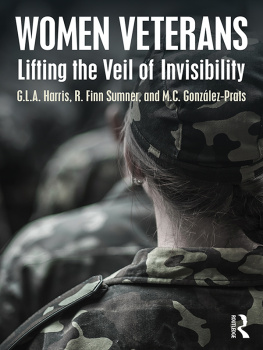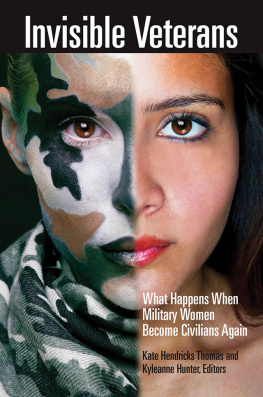Women Veterans
Women who fight in wars also have to fight for their right to do so. But what are the obstacles impeding their progress in achieving equal status as both active service members and as veterans? This book, written by a team of female veterans and military scholars, demonstrates the ways in which women service members and veterans experience a unique set of challenges when attempting both to serve their country honorably and reintegrate into civilian society following military service. These challenges include but are not limited to discrimination, staggering rates of suicide, and barriers to obtaining treatment for military sexual trauma and other critical benefits through the U.S. Department of Veterans Affairs.
Women Veterans: Lifting the Veil of Invisibility examines current service-related policies and gender in the militarys hierarchical power structure. Here, a confluence of white male privilege and entitlement, the culture of domination, and the effeminization of the enemy manifest themselves as a backlash against women, calling into question a womans agency and her very status as a citizen. Special attention in the book is paid to the civil-military divide, representative bureaucracy, and the function of the military and civilian justice systems. Moreover, the need for appropriate healthcare policies and structures is examined within a wicked problems framework. The authors conclude that the responsibility for women veterans, and all veterans for that matter, must become a matter of compelling government interest. This ground-breaking book is required reading for practitioners of public policy and administration with an interest in military and veterans affairs, public health, nongovernmental organizations and activist groups, as well as scholars of gender and public service, public personnel management, and nonprofit management.
G.L.A. Harris is a Professor of Public Administration in the Mark O. Hatfield School of Government at Portland State University, Portland, Oregon. A two time named Fulbright Commission distinguished scholar as Research Chair in North American Integration and as NATO Chair in Security Studies, Dr. Harris is also a Commissioned Officer in the U.S. Air Force Reserve and formerly served on active duty in the U.S. Air Force. She is also a graduate of the U.S. Air Forces junior, intermediate and senior service schools, including Air War College.
R. Finn Sumner is Assistant Professor of Public Administration at Portland State University, U.S.
M.C. Gonzlez-Prats served in the Army from 1998 to 2004 as an enlisted reservist, and later, as an active duty supply and logistics officer. She is currently pursuing a Ph.D. in Social Work at Portland State University (PSU), and is a TL1 fellow at the Oregon Health Sciences University (OHSU) Clinical and Translational Research Institute.
There is no other book that addresses the challenges women face in the military as the authors have done in Women Veterans: Lifting the Veil of Invisibility. This book represents a comprehensive, systematic examination of the uphill battles that women are forced to endure by the white-male, hierarchical power structure of the military. The authors should be celebrated for their candid and accessible treatment of this significant, formidable topic.
Norma M. Riccucci, Rutgers University, USA
Women Veterans
Lifting the Veil of Invisibility
G.L.A. Harris, R. Finn Sumner, and M.C. Gonzlez-Prats
First published 2018
by Routledge
711 Third Avenue, New York, NY 10017
and by Routledge
2 Park Square, Milton Park, Abingdon, Oxon OX14 4RN
Routledge is an imprint of the Taylor & Francis Group, an informa business
2018 Taylor & Francis
The right of G.L.A. Harris, R. Finn Sumner, and Maria Carolina Gonzlez-Prats to be identified as authors of this work has been asserted by them in accordance with sections 77 and 78 of the Copyright, Designs and Patents Act 1988.
All rights reserved. No part of this book may be reprinted or reproduced or utilised in any form or by any electronic, mechanical, or other means, now known or hereafter invented, including photocopying and recording, or in any information storage or retrieval system, without permission in writing from the publishers.
Trademark notice: Product or corporate names may be trademarks or registered trademarks, and are used only for identification and explanation without intent to infringe.
Library of Congress Cataloging-in-Publication Data
A catalog record for this book has been requested
ISBN: 978-1-4987-2760-0 (hbk)
ISBN: 978-1-351-20115-5 (ebk)
Even as a majority in American society, women are routinely marginalized in multiple venues and especially so where they become the default and underclass in predominantly male institutions like the military. As Kanter (1977) notes, for women to become streamlined as an accepted part of the milieu, on one hand, they must comprise at least 15 percent of the organization for a critical mass and within an occupation. Yet, on the other hand, Kanter admits that achieving critical mass becomes a conundrum for women as it in no way guarantees their acceptance by men in certain facets of organizational life. In fact, as Kanter continues, for women, this critical mass may bring about a degree of unwanted hypervisibility simply because they are women. Thus, womens existence in society, and as the overwhelming research suggests, is predicated on and is one of invisibility even where women represent the majority, and in the process brings unwarranted visibility to them as a group (Kanter 1977, Harris 2012, Vojdik 2002, Firor Scott 1984). Harris (2009) cites the case of Sergeant (Sgt.) Leigh Ann Hester, who, during the initial stages of Operation Iraqi Freedom, was awarded the Silver Star for valor. Hester was also only the second woman recipient of this medal since World War II. When asked by a reporter how she felt about receiving the medal as a woman, Sgt. Hester deliberately sidestepped the question in an attempt to deflect attention from herself. She simply invoked that the receipt of the medal was about her performance as a soldier and was not to be attributed to her gender (Lumpkin 2005, Harris 2009). Sgt. Hesters response, though appropriate, signals the lengths to which women veterans, and notably those in nontraditional jobs, will go to avoid bringing attention to themselves, given gender. Yet, such acts only serve to reinforce their invisibility.
Gardam (1997) describes acts of violence against women, including as combatants, during times of armed conflict when their concerns are routinely subordinated to those of men despite the fact that such matters are legally protected, though rarely enforced, under the Geneva Convention. Making things worse, men are the ones who collect the data that should facilitate the case for prosecution but which only intensifies the dilemma for women. Accordingly, it was only the increased presence of female reporters at the Yugoslavian conflict, as one example, that brought the plight of womens issues to light. Though it is generally acknowledged that women routinely become the spoils of war, their concerns remain hidden from view. To McElrath (1992), these affairs, or those that are perceived to be only within the purview of women, then do not become the concern of others, who are men. This entrenched silence only fuels womens cumulative invisibility.








![Louis Hicks - The Civilian Lives of U.S. Veterans: Issues and Identities [2 volumes]](/uploads/posts/book/133676/thumbs/louis-hicks-the-civilian-lives-of-u-s-veterans.jpg)
